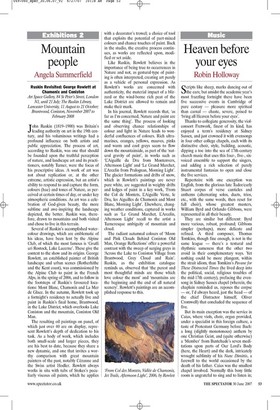Mountain people
Angela Summerfield Ruskin Revisited: George Rowlett at Chamonix and Coniston Art Space Gallery, 84 St Peter's Street, London Ni, until 21July; The Ruskin Libraiy, Lancaster University, 11 August to 21 October; Brantwood, Coniston, November 2007 to Feb/vary 2008 John Ruskin (1819-1900) was Britain's leading authority on art in the 19th century, and his voluminous writings had a profound influence on both artists and public appreciation. The process of art, according to Ruskin, was one that should be founded upon the truthful perception of nature, and landscape art and its practitioners, notably Turner, were the focus of his prescriptive ideas. A work of art was not about replication or, at the other extreme, artistic expression, but an artist's ability to respond to and capture the form, colours (hue) and tones of Nature, as perceived at certain times of day, or under key atmospheric conditions. As art was a celebration of God-given beauty, the more sublime and awe-inspiring the landscape depicted, the better. Ruskin was, therefore, drawn to mountains and both visited and chose to live in this terrain.
Several of Ruskin's accomplished watercolour drawings, which are emblematic of his ideas, have been lent by the Alpine Club, of which the most famous is `Grutli uri Rostock, Lake Lucerne'. These give the context to the show and its origins. George Rowlett, an established painter of British landscape and urban scenes (Rotherhithe and the Kent coast), was commissioned by the Alpine Club to paint in the French Alps, in the spring of 2006, and to follow in the footsteps of Ruskin's favoured locations: Mont Blanc, Chamonix and La Mer de Glace. In the autumn, Rowlett took up a fortnight's residency to actually live and paint in Ruskin's final home, Brantwood, in the Lake District, which overlooks Lake Coniston and the mountain, Coniston Old Man.
The resulting oil paintings on panel, of which just over 40 are on display, represent Rowlett's depth of dedication to his task. As a body of work, which includes both small-scale and larger pieces, they are his best to date, because they share a new dynamic, and one that invites a worthy comparison with great mountain painters of the past, notably Cezanne and the Swiss artist Hodler. Rowlett always works in situ with tubs of Stokes's peculiarly viscous oil paints, which he applies with a decorator's trowel; a choice of tool that exploits the potential of part-mixed colours and chance touches of paint. Back in the studio, the creative process continues, as works are reflected upon, modified or set aside.
Like Ruskin, Rowlett believes in the importance of being true to occurrences in Nature and not, as gestural-type of painting is often interpreted, creating art purely as a vehicle of personal expression. As Rowlett's works are concerned with authenticity, the material impact of a blizzard or the wind-borne rich peat of the Lake District are allowed to remain and make their mark.
In his journal, Rowlett records that, 'as far as I'm concerned, Nature and paint are the same thing'. The process of looking and observing chance relationships of colour and light in Nature leads to wonderful confluences of colours. Rich ultramarines, oranges, yellows, mauves, pinks and warm and cool greys seem to flow down the mountainside, as part of the 'natural gravity of paint', in works such as T:Aiguille du Dru from Montenvers, Afternoon Light' and 'Le Grand Marchet, EArcelin from Pralognan, Morning Light'. The glacier formations and drifts of snow, which in Rowlett's paintings are never pure white, are suggested in weighty drifts and ledges of paint in a key work, 'From the Col de Montets, LAiguille Verte, le Dru, les Aiguilles de Chamonix and Mont Blanc, Morning Light'. Elsewhere, changing weather conditions, captured in works such as 'Le Grand Marchet, EArcelin, Afternoon Light' recall to the artist a Turneresque ambiguity of mountain and cloud.
The radiant autumnal colours of 'Moon and Pink Clouds Behind Coniston Old Man, Orange Reflections' offer a powerful contrast with the sweep of surging greys in 'Across the Lake to Coniston Village from Brantwood, Grey Cloud and Rain'. Ruskin, as the exhibition catalogue reminds us, observed that `the purest and most thoughtful minds are those which love colour the most' and 'mountains are the beginning and the end of all natural scenery'. Rowlett's paintings are an accomplished response to this.


















































































 Previous page
Previous page